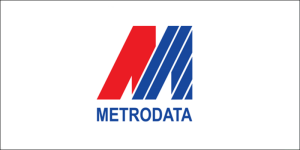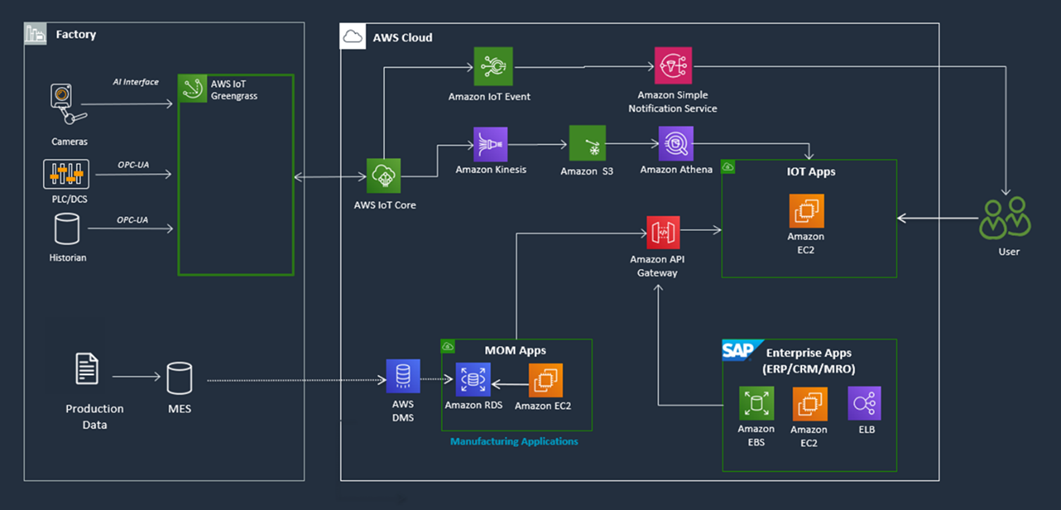AWS Partner Network (APN) Blog
Digitalize Your Factory Performance on AWS with Metrodata Electronics
By Wahyu Kuncoro Adhi, IoT Technical Consultant – Metrodata Electronics
By Lalit Mangla, Sr. Partner Solution Architect – AWS
By Sefiani Marouane, Sr. Partner Solution Architect – AWS
 |
| Metrodata |
 |
In a manufacturing process, reports are critical for tracing problems and improvement. Technologies such as Industrial IoT (IIoT) can help companies improve reporting accuracy and traceability during the manufacturing process. With reliable and available data, factories can solve problems better and improve their operations.
Indonesia is the fifth most cost competitive manufacturing hub and 10th largest manufacturing country in the world. Digitizing manufacturing represents a substantial business opportunity and provides a path for Indonesian manufacturers to improve their competitivity. Central monitoring and reporting can be achieved using digital technology.
Many factories in Indonesia still use manual reporting, which is hard to trace, prone to human errors, and reduces overall productivity. When a problem happens, finding the root cause is difficult due to non-timely and inaccurate data.
To enable customers to collect reliable and timely data from their factories, Metrodata Electronics chose Amazon Web Services (AWS) as a trusted platform to build its IoT offerings such as digital factory reports.
Metrodata is an AWS Advanced Tier Services Partner and veteran systems integrator in Indonesia since 1975. Metrodata is committed to providing comprehensive and innovative cloud solution offerings for organizations in the Indonesian market. Offerings include cloud computing solutions, business and technical consulting, data center assessment, migration, implementation, and managed services.
Solution Architecture and Overview
Metrodata’s solution architecture aims for easy access as a reliable, durable, secure platform so customers no longer need to think about problems that may arise due to limited storage and lack of computing capabilities.
With AWS providing highly available serverless services, Metrodata’s solution is built for accelerated data analysis development and can be applied immediately with minimal efforts.
Machines using industrial protocols are connected to an AWS IoT Greengrass device so machine data can be sent to the cloud. This data is used to generate digital reports, populate dashboards, and notify operations teams of any events in the factory. Reports can be consumed from a web browser.
Digital factory reports provides the following insights:
- Comparison of factory output in different years.
- Production line effectiveness and key performance indicators (KPIs).
- Comparison between actual and planned output on a yearly and monthly basis.
- Key parameters for root cause analysis.
Figure 1 – Detailed high-level end-to-end architecture.
Factory Site
Metrodata’s solution has four data sources:
- Camera for people detection, object detection, defect detection, and other use cases.
- Programmable logic controller (PLC) has many brands and various industrial protocols. With the right open platform communication (OPC) technologies and hardware, users can connect data to PLC and distributed control system (DCS).
- Open platform communications unified architecture (OPC-UA) historians.
- Production data installed on manufacturing execution system.
Data sources 1-3 can be connected to AWS IoT Greengrass, which will be installed at the edge and communicate with AWS IoT Core in the cloud. Regarding the fourth data source, Metrodata uses AWS Data Migration Service (AWS DMS) to get data from the factory manufacturing execution system.
AWS Cloud
From AWS IoT Core, data:
- (Hot) data which needs to be acted upon quickly will flow to AWS IoT Events and send notifications through Amazon Simple Notification Service (SNS).
- All data will flow to Amazon Kinesis and is stored in Amazon Simple Storage Service (Amazon S3). Data will be queried through Amazon Athena to generate datasets which are consumed by the IoT applications.
For production and enterprise resource planning (ERP) data, Metrodata uses Amazon API Gateway to send data to IoT applications.
Digital Report Analysis
Customers always have challenges to fill up their production report, and sometimes reports are not accurate because of human errors—especially during the heavy workload time. With the digital report directly from the machine, customers can get accurate data and reduce the workload of their resources. Report data is also important when something isn’t right and can be used to find the root cause.
Below is an example of a digital report generated after collection of the data from machines, and how whole batch got processed with material code, quantity, and time spend on each step of the process.
Figure 2 – Digital report showing batch processing time and quantity produced.
Production Tracking
In manufacturing, production tracking is a strategy used by businesses to measure, analyze, and improve visibility throughout the manufacturing process, from raw material to completed product. In a world where tracking production has become a critical element of maintaining a competitive edge, manufacturers are constantly looking for the best tools to simplify their process and improve efficiency.
The product tracking dashboard below helps operators look at the whole production line—hourly production, performance against hourly and daily goals, and the unit running with full efficiencies and defects reported. This is the mechanism to increase the production yield by optimizing the production line.
Figure 3 – Production tracking.
Real-Time Dashboard
The real-time dashboard is a visual representation of a manufacturing process. Manufacturing dashboards combine graphs, tables, and other visualization techniques to make production KPIs easy to understand for the operations.
The chart below shows how data is organized from machines, sensors, devices, and workers into easy-to-read, instantly available breakdowns that the whole operation can reference.
Figure 4 – Revenue and customer growth.
Metrics for Success
The first metric of success for this solution is linked to the productivity gains by automating the data collection process from the factory floor and improving the quality of data being collected by using IoT.
The second is the ability to conveniently share this data with operational teams wherever they may be located geographically.
The final success metric is linked to leveraging the elasticity of the cloud and managed services to generate cost savings by paying only for the infrastructure being used rather than provisioning for the peak.
Lessons Learned
Although manufacturers are under pressure to improve their productivity as well as reduce costs though digitization and IoT, manufacturing processes and equipment vary significantly between different verticals.
One the lessons learned was to focus the Metrodata solution on a limited number of verticals, such as automotive manufacturing, to make it more repeatable. Implementation challenges regarding data collection, data visualization, and report generation would be similar in the same vertical.
Lessons learned on how to liberate data from the shop floor or what customization is required for the digital reports can be reused from one customer to another in the same industry.
Conclusion
In this post, we showed how Metrodata and AWS IoT services can be used to detect real-time performance in the manufacturing unit and pinpoint the exact location of the performance issues.
This solution can lead to a reduction in time to fix problems, thereby proactive monitoring and remediation and improving environmental impact. The same solution can be extended to manufacturing as well as oil and natural gas customers.
To learn more about how to use AWS IoT Core, you can refer to the documentation.
Metrodata – AWS Partner Spotlight
Metrodata Electronics is an AWS Advanced Tier Services Partner and veteran systems integrator in Indonesia since 1975. Metrodata is committed to providing comprehensive and innovative cloud solution offerings for organizations in the Indonesian market.




